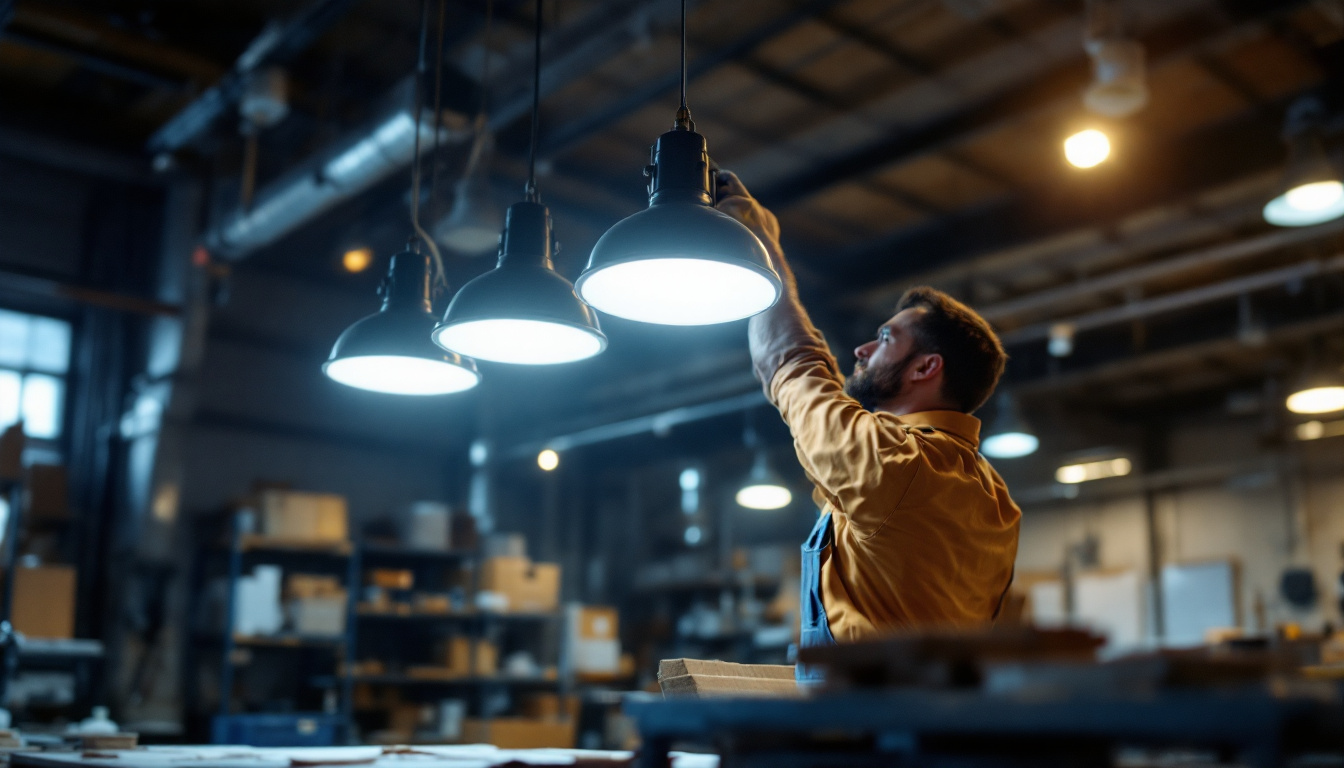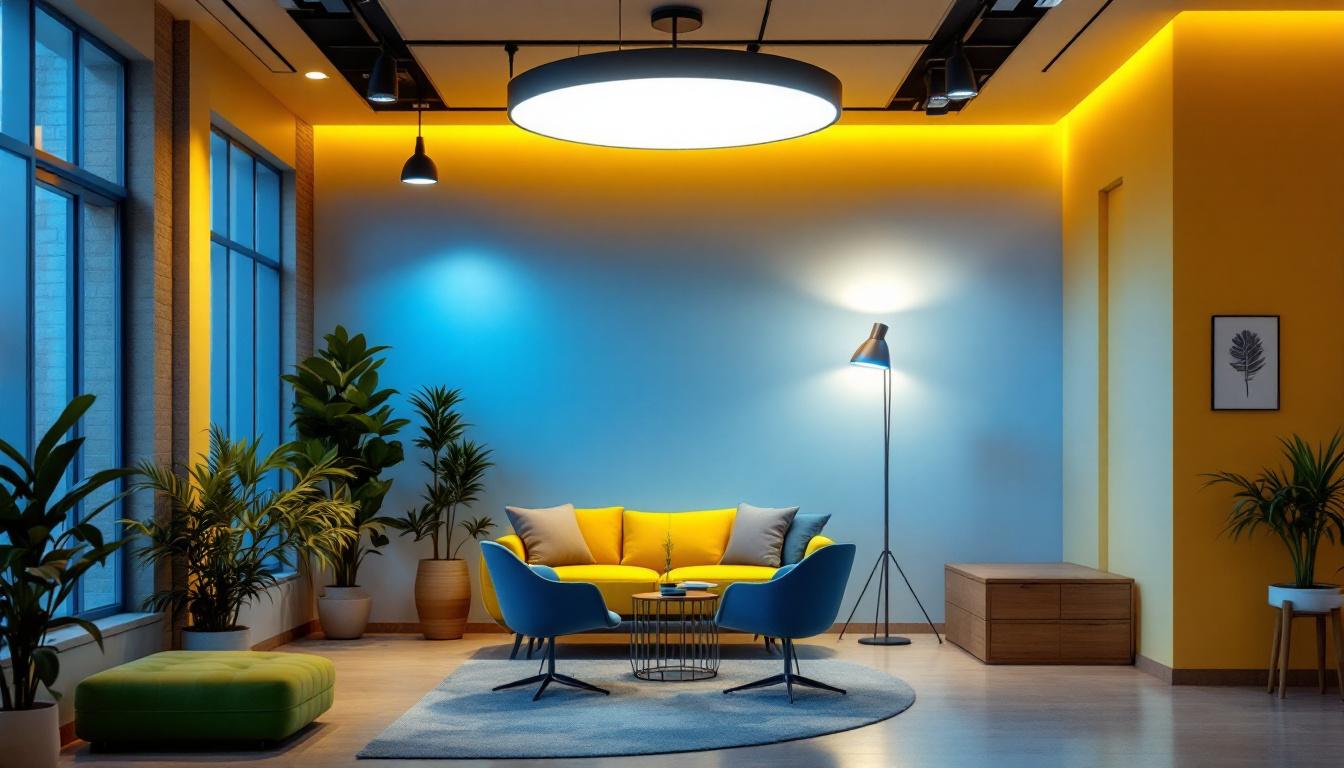
In the evolving landscape of commercial and industrial lighting, hardwired LED shop lights have emerged as a preferred choice for lighting contractors. These fixtures not only provide superior illumination but also offer energy efficiency and longevity, making them a cost-effective solution for various applications. This article delves into proven methods for effectively utilizing hardwired LED shop lights, ensuring that contractors can maximize their benefits while meeting client needs.
Hardwired LED shop lights are permanently connected to the electrical system of a building, offering a sleek and professional appearance. Unlike plug-in models, these fixtures require installation by a qualified electrician, ensuring safety and compliance with local codes. The hardwired nature of these lights allows for a more streamlined design, reducing clutter and enhancing the overall aesthetic of the workspace. This is particularly beneficial in commercial settings where a clean and organized look is essential for both employee morale and customer perception.
One of the primary advantages of hardwired LED shop lights is their energy efficiency. Compared to traditional fluorescent or incandescent bulbs, LEDs consume significantly less power, which translates to lower energy bills for businesses. Additionally, the longevity of LED technology means that these lights can last for years without needing replacement, further reducing maintenance costs. This durability is especially advantageous in high-usage environments, such as warehouses or manufacturing facilities, where frequent bulb changes can disrupt operations and incur additional labor costs.
Moreover, hardwired LED shop lights offer superior light quality. They provide bright, consistent illumination that can enhance visibility in workspaces, improving safety and productivity. Many models are also available in various color temperatures, allowing contractors to choose the right ambiance for different environments. For instance, cooler white lights can create a more alert atmosphere ideal for precision tasks, while warmer tones may be more suitable for areas where comfort and relaxation are prioritized, such as break rooms or lounges.
When installing hardwired LED shop lights, several factors must be taken into account. First, it is essential to assess the layout of the space to determine the optimal placement of fixtures. This involves considering the height of the ceilings, the size of the area, and the specific tasks being performed within the space. Proper placement not only maximizes light distribution but also minimizes shadows and dark spots that can hinder productivity.
Another critical aspect is ensuring that the electrical system can support the new lighting. Contractors should evaluate the existing wiring and circuit capacity to avoid overloading the system. In some cases, it may be necessary to upgrade the electrical infrastructure to accommodate the additional load. Furthermore, integrating smart lighting controls can enhance the functionality of hardwired LED shop lights, allowing for features such as dimming, scheduling, and motion sensing, which can further optimize energy use and adapt to the dynamic needs of the workspace.
Selecting the appropriate hardwired LED shop lights involves understanding the specific needs of the project. Factors such as lumen output, color temperature, and fixture design play a crucial role in ensuring optimal performance.
Lumen output is a key metric that indicates the brightness of a light fixture. For shop environments, it is essential to choose lights that provide sufficient lumens to illuminate the space effectively. A general rule of thumb is to aim for at least 50 lumens per square foot, although this may vary depending on the nature of the work being performed.
Contractors should also consider the layout of the lighting. In larger spaces, multiple fixtures may be required to achieve uniform brightness. It is advisable to create a lighting plan that outlines the placement and type of fixtures to ensure adequate coverage. Additionally, the height at which the fixtures are mounted can influence the light distribution; higher ceilings may require fixtures with a higher lumen output to maintain effective illumination across the entire area.
The color temperature of LED lights is measured in Kelvin (K) and can significantly impact the mood and functionality of a workspace. For example, cooler temperatures (5000K and above) are ideal for tasks requiring high concentration and visibility, such as assembly or detailed work. Conversely, warmer temperatures (3000K to 4000K) can create a more relaxed atmosphere, suitable for areas where employees may take breaks or collaborate.
Understanding the specific needs of the workspace can guide contractors in selecting the right color temperature, ultimately enhancing the overall experience for employees and visitors. Furthermore, it is important to consider how natural light interacts with artificial lighting. In spaces with large windows or skylights, the color temperature of the LED lights should complement the natural light to create a cohesive and inviting environment. This can help reduce eye strain and improve productivity, as employees are less likely to feel fatigued in a well-lit space that harmonizes with the daylight outside.
Proper installation is crucial to ensure the longevity and performance of hardwired LED shop lights. Following best practices not only enhances safety but also maximizes the effectiveness of the lighting solution.
Before beginning the installation process, it is vital to adhere to safety protocols. This includes turning off the power to the area where the installation will take place, using appropriate personal protective equipment (PPE), and ensuring that all tools and materials are in good condition. Contractors should also familiarize themselves with local electrical codes and regulations to ensure compliance.
In addition, it may be beneficial to have a second person assist during the installation process. This can help prevent accidents and ensure that fixtures are securely mounted and properly aligned.
There are various mounting techniques for hardwired LED shop lights, depending on the fixture design and the specific application. Surface-mounted fixtures are commonly used in commercial settings, providing a clean look while allowing for easy access to the electrical connections. Suspended fixtures, on the other hand, are ideal for spaces with high ceilings, as they can be hung at an optimal height for illumination.
Regardless of the mounting method, it is essential to follow the manufacturer’s instructions carefully. This includes using the appropriate hardware and ensuring that the fixture is securely fastened to prevent any accidents or damage.
While hardwired LED shop lights are known for their durability, regular maintenance is still essential to ensure optimal performance. Understanding common issues and how to address them can save contractors time and resources.
Conducting regular inspections of the lighting fixtures is crucial for identifying potential issues before they escalate. This includes checking for signs of wear and tear, such as flickering lights or discoloration. Additionally, inspecting the electrical connections can help prevent malfunctions caused by loose wiring or corrosion.
It is advisable to create a maintenance schedule that outlines when inspections should take place. This proactive approach can help extend the lifespan of the fixtures and maintain consistent performance.
In the event of a lighting issue, contractors should be equipped with troubleshooting techniques. For instance, if a fixture is flickering, it may indicate a loose connection or a failing driver. In such cases, turning off the power and inspecting the connections can often resolve the problem.
Additionally, if multiple fixtures are experiencing issues, it may be indicative of a larger electrical problem. In these cases, consulting with a licensed electrician is recommended to ensure the safety and integrity of the electrical system.
Energy efficiency is a significant consideration for many businesses today, and hardwired LED shop lights play a crucial role in achieving sustainability goals. By reducing energy consumption, these fixtures not only lower operating costs but also contribute to a smaller carbon footprint.
Many governments and utility companies offer incentives for businesses that invest in energy-efficient lighting solutions. These can include rebates, tax credits, or grants that help offset the initial costs of purchasing and installing hardwired LED shop lights. Contractors should stay informed about available programs in their area, as this can provide added value to clients.
Furthermore, promoting the energy-saving benefits of LED lighting can enhance a contractor’s reputation as a knowledgeable and environmentally conscious professional. This can be a significant selling point when bidding on projects or attracting new clients.
While the upfront cost of hardwired LED shop lights may be higher than traditional lighting options, the long-term savings are undeniable. The reduced energy consumption, combined with the extended lifespan of LEDs, results in significant cost savings over time. Businesses can allocate these savings to other areas, such as employee training or equipment upgrades.
Contractors should emphasize these long-term benefits to clients, helping them understand the value of investing in quality lighting solutions. By presenting a comprehensive cost analysis, contractors can build trust and demonstrate their expertise in the field.
Hardwired LED shop lights represent a significant advancement in lighting technology, offering numerous benefits for contractors and clients alike. By understanding the advantages, installation techniques, and maintenance requirements, lighting contractors can provide superior solutions that enhance productivity and safety in various work environments.
As the demand for energy-efficient and sustainable lighting solutions continues to grow, embracing hardwired LED technology will be essential for contractors looking to stay competitive in the industry. By leveraging proven methods and best practices, lighting professionals can ensure their projects are successful and meet the evolving needs of their clients.
In a world that increasingly values efficiency and sustainability, hardwired LED shop lights are not just a trend—they are a cornerstone of modern lighting design. By adopting these solutions, contractors can illuminate the path to a brighter, more efficient future.
Ready to take your lighting projects to the next level? At LumenWholesale, we provide lighting contractors like you with the highest quality, spec-grade hardwired LED shop lights at unbeatable wholesale prices. Say goodbye to local distributor markups and hello to a vast selection of reliable, high-performance lighting that meets the strictest industry standards. With the added benefits of free shipping on bulk orders, you can trust that you’re getting premium lighting solutions at the best value — without any hidden fees. Elevate your lighting installations with the efficiency and sustainability of LumenWholesale products. Wholesale Lighting at the Best Value is just a click away.

Discover expert techniques and innovative strategies for lighting contractors to effectively install hanging lanterns.

Discover why lighting contractors should prioritize envisioning lighting in their projects.

Explore the rising significance of top-down lighting in the industry, uncovering its benefits, innovative applications, and how it’s shaping the future of illumination design.

Discover innovative cost-saving strategies for lighting contractors in this insightful article.